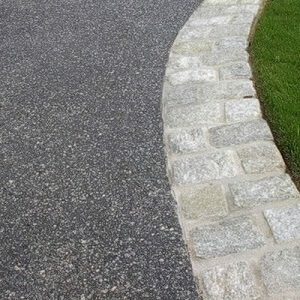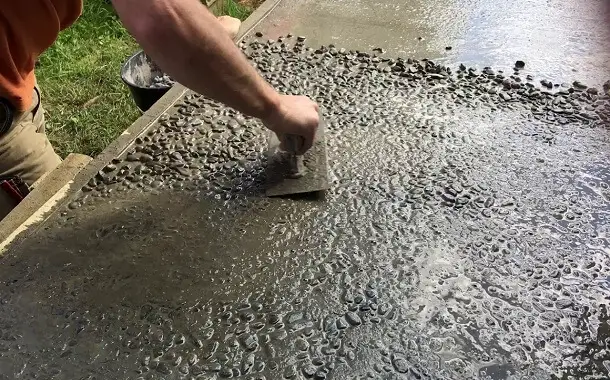Cost To Install Exposed Aggregate Concrete
Last Updated on August 5, 2022
Written by CPA Alec Pow | Content Reviewed by ![]() CFA Alexander Popinker
CFA Alexander Popinker
A good way to improve the functionality and appearance of concrete surfaces such as floors, parking aprons, and driveways is by installing exposed aggregate concrete.
Concrete with exposed aggregates is a decorative solution and durable outdoor space design (roads and paths access, esplanades, terraces, stairs, etc.). In exposed aggregate concrete, the aggregates (stones), usually embedded in concrete, are left visible to create as many good-looking surfaces as possible. By using beautiful aggregates or by introducing pigments, glass, or phosphorescent aggregates into the concrete mass, an extremely attractive image can be created.
How Much Does It Cost To Install Exposed Aggregate Concrete?
The expenses of applying an average type of exposed concrete are affected by a few factors such as the labor rate, surface area, special preparation needs, and the color and type of stones.
In the table below you will find the average costs of installing exposed aggregate concrete for a 500-square feet surface. The costs of excavation, preparation, pouring, and wash-finish of a 2 inches thick concrete slab with rebar, wire mesh, and sand/aggregate base, are all included in this price. Also, these estimates include the costs of equipment, transport, waste, and medley materials.
| Item | Unit Cost | Quantity | Line Cost | |
|---|---|---|---|---|
| Exposed aggregate finish | $2.75 | per sq.ft. | 525 | $1,445 |
| Upgrades | $0.50 | per sq.ft. | 525 | $262,5 |
| Material Cost | $3.20 | per sq.ft. | 500 | $1,600 |
| + Labor Cost (base) | $45 | per hour | 32 | $1,440 |
| + Labor Cost (upgrade) | $45 | per hour | 15 | $675 |
| Total Cost | $6.75 | per sq. ft. | 500 | ~$5,000 |
Cost considerations
Fees with permits and taxes are not included in the price estimates presented above.
Expect to pay around $50 per cubic yard for the extra hand excavation of common soil.
You might also like our articles on the cost of saw cutting concrete, precast concrete, or concrete delivery.
Be prepared to pay $0.75 to $2 per square foot for the common residential site clearing and preparation work, depending on transport, and size and amount of material.
These cost estimates are available for the jobs located in the close area of the professional.
General information
 There are different techniques for producing concrete with exposed aggregates, each of which provides a distinct and surprising aspect. The technique of exposing the aggregates is relatively simple, consisting of the application of a setting delay product on the surface of the freshly poured concrete. After the concrete has hardened (generally 18-24 hours after pouring), the surface is cleaned with a strong water jet in order to remove the superficial, inert layer of mortar/cement paste, thereby exposing the aggregates.
There are different techniques for producing concrete with exposed aggregates, each of which provides a distinct and surprising aspect. The technique of exposing the aggregates is relatively simple, consisting of the application of a setting delay product on the surface of the freshly poured concrete. After the concrete has hardened (generally 18-24 hours after pouring), the surface is cleaned with a strong water jet in order to remove the superficial, inert layer of mortar/cement paste, thereby exposing the aggregates.
Applications – Areas of use
Both due to the aesthetic effect and the durability and anti-slip effect, concrete with exposed aggregates is used in various projects such as:
Public projects
- pedestrian areas (streets, squares, esplanades, seafronts)
- parking lots, passages, roundabouts, sidewalks, runways
For bicycles
- alleys, parks, and gardens
- facades, supporting walls, and walls.
Private, residential, and/or commercial projects
- access roads, parking lots
- terraces, garden paths
- edge areas of swimming pools
- fences, stairs, plinths, and decorative walls.
Advantages of exposed aggregate concrete
Aesthetics and versatility
- Exterior and interior applications in both horizontal and vertical elements;
- Harmonization in various environmental contexts.
Functionality
- Anti-slip effect (textured surface increases slip resistance);
- Can be poured on sloping or uneven surfaces;
- Easy to maintain.
Resistance and durability
- Durability over time, in varied conditions of temperature and humidity;
- High wear resistance.
Recommendations for installing exposed aggregate concrete
- Before pouring, work will be carried out to prepare the support layer, which includes adequate compaction of the soil and obtaining the best possible flatness.
- Pouring concrete with exposed aggregates is done with a chute or a trowel. In the case of vertical elements, it can be poured with the pump, ensuring the access of the hose in the formwork, up to the pouring area.
- The support will be moistened before pouring and, if necessary, it will be protected with a film.
- Avoid compacting the concrete in excess, to prevent the migration of large aggregates from the surface to be processed.
- No water or other materials will be added to the concrete on the construction site.
- The surface of the freshly poured concrete must be protected, delimited, and signalized accordingly until it is put into operation.
- Concrete works with exposed aggregates will not be carried out if there are forecasts of rain or excessive temperatures (heat or cold).
- If the outside temperatures are low, the concrete will be protected so that it can be washed after 24 hours.
DIY considerations
As you will need special skills and tools for this project, this is not a job recommended for DIY.
Besides construction skills, you should take into consideration that the concrete dries pretty fast so it does not forgive delays.


Leave a Reply
Want to join the discussion?Feel free to contribute!